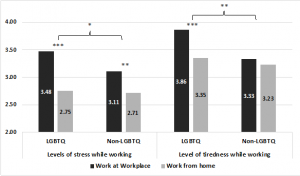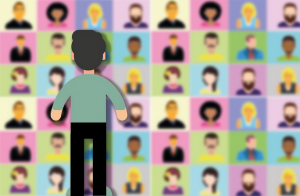The COVID-19 pandemic has taken a toll on mental health for individuals and families across the country, with recent analysis finding more than four in ten U.S. adults have endured high levels of psychological distress at some point during the pandemic. Because of structural inequalities, some groups have been harder hit than others. One group that has experienced disproportionately large drops in emotional well-being during COVID is LGBTQ+ (lesbian, gay, bisexual, transgender, queer, and other sexual and gender minority) people. Even before the pandemic, LGBTQ+ adults—particularly Black, Latinx, and multiracial LGBTQ+ people—faced structural discrimination and day-to-day mistreatment that strained well-being at work and elsewhere.
How have pandemic-related changes to paid work affected LGBTQ+ well-being outcomes? As the pandemic took hold, many people had to work in-person amid new risks to their health and finances, while others, typically more advantaged workers, found themselves working from home in a world of Zoom meetings. Past research suggests working from home could be protective for LGBTQ+ workers’ well-being, if working remotely from a supportive home environment means less exposure to stressors like workplace microaggressions. On the other hand, the blurred work/home border of remote work could also be harmful for well-being. For example, it could increase stress for those who try to guard against mistreatment by keeping a strict separation between work and home life, such as by not talking about a same-gender partner at work.
With prior research pointing in inconclusive directions, we asked: how has work location mattered for the well-being of LGBTQ+ adults since the onset of the pandemic?
To investigate this question, we worked with a team of other researchers to analyze survey and time diary data (reports of how, where, and with whom respondents spent their time for a 24-hour day) from the Assessing the Social Consequences of COVID-19 Study, collected online between April 2020 and July 2021. We looked at respondents’ “experienced well-being”—in other words, how someone reports they are feeling minute-to-minute—while they were working. We compared whether experienced well-being while doing paid work was different for LGBTQ+ workers and cisgender heterosexual (i.e., non-LGBTQ+) workers, and whether well-being differed across work locations.
As described in our recent article published in the journal Social Science & Medicine, we found that work location did indeed make a difference for well-being, especially for LGBTQ+ respondents. LGBTQ+ adults felt more stressed and tired while working in a workplace compared to while working from home (Figure 1). While non-LGBTQ+ adults were also less stressed while working at home, work location had a smaller impact on their stress level and almost no impact on their tiredness level. Working in-person at a workplace during the pandemic appeared to be more harmful to LGBTQ+ individuals’ experienced well-being, compared to that of their non-LGBTQ+ counterparts.
Figure 1. Predicted means of LGBTQ workers’ and non-LGBTQ workers’ feelings of stress and tiredness by work location (N=7,650 work episodes across 3,515 respondents).

We also investigated what kinds of factors might help account for the gaps we observed in stress and tiredness between LGBTQ+ and non-LGBTQ+ adults across work locations. For example, does adjusting for work characteristics, socioeconomic factors, or family characteristics help explain the results?
We found that work characteristics—like total time working that day, duration of each work episode, and whether or not respondents found interactions with their co-workers to be exhausting—played an important role. Collectively, work characteristics explained about 35 percent of the stress gap and 24 percent of the tiredness gap. When working in-person at a workplace, the duration of work episodes (i.e., how many minutes someone is working at one time) tended to be longer for LGBTQ+ workers than non-LGBTQ+ workers, whereas the reverse was true among people working from home.
It could be that LGBTQ+ adults working in-person during COVID are more often in jobs with strict schedules and limited control over work pace, meaning they are not able to take a break when feeling stressed or tired. This would be consistent with other analyses showing that LGBTQ+ people are overrepresented in some face-to-face service positions like restaurant-based jobs.
Another factor that may be contributing to the stress and tiredness gaps across work location for LGBTQ+ adults is greater exposure to workplace microaggressions related to sexual and gender identity, race/ethnicity, and other statuses. In our survey data, LGBTQ+ respondents were more likely than their cisgender heterosexual counterparts to characterize interacting with co-workers as frequently exhausting. It is possible that working from home is helping to buffer some of the “minority stress” LGBTQ+ individuals too often face at work.
LGBTQ+ adults are, of course, far from a homogenous group. Strains on well-being while working may be compounded for multiply-marginalized LGBTQ+ adults who are also subject to racial discrimination, mistreatment based on disability status, or other forms of bias and exclusion at work. An important limitation of the study is the relatively small survey sample size. This restricted our ability to fully examine well-being experiences separately across sexual and gender minority groups (lesbian, gay, bisexual, transgender, queer, and other sexual and gender minority identities), and intersections with racial/ethnic identities. However, comparing descriptive well-being reports using four broad groups (LGBTQ+ respondents of color, LGBTQ+ white respondents, non-LGBTQ+ respondents of color, and non-LGBTQ+ white respondents) indicated that although working in-person was linked to higher stress for all LGBTQ+ adults, this was especially so for LGBTQ+ adults racialized as Black, Hispanic/Latinx, Asian, multiracial, or another race/ethnicity compared to LGBTQ+ adults racialized as white. In light of emerging research indicating there may be differences in working-from-home experiences across racialized groups, a deeper dive into how structural racism, heterosexism, cisnormativity, and other forms of inequality may jointly influence well-being experiences across work locations is warranted.
For many workers, remote work in some form is here to stay. A more complex understanding of how work location may impact well-being—particularly for individuals not traditionally centered in research on work, family, and health—will be critical to supporting the emotional well-being of marginalized workers both today and in the future.
Layne Amerikaner (@LayneAmerikaner) and Hope Xu Yan (@HopeYanxu) are doctoral candidates in the Department of Sociology at the University of Maryland, College Park. You can read more about Amerikaner’s research here and about Yan’s research here. The study described in this blog post was published in Social Science & Medicine in April 2023. The study was authored by Layne Amerikaner, Hope Xu Yan (equal first authorship), Liana C. Sayer, Long Doan, Jessica N. Fish, Kelsey J. Drotning, and R. Gordon Rinderknecht.


Comments